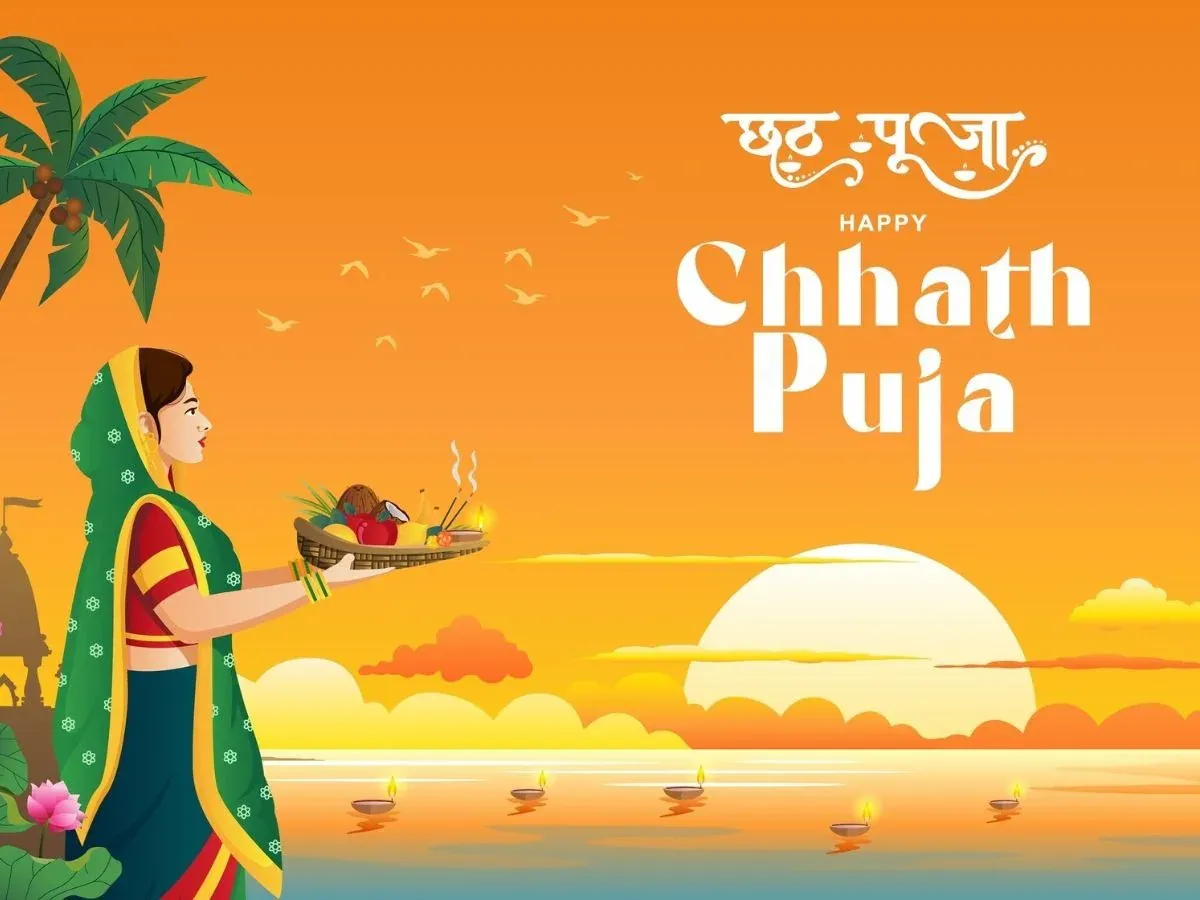Chhath Puja is one of the most devoted and spiritual festivals celebrated mainly in Bihar, Jharkhand, Uttar Pradesh, and some parts of Nepal. This four-day festival is dedicated to Surya Dev (Sun God) and Chhathi Maiya, the mother goddess who is believed to protect and bless her devotees with health, happiness, and prosperity.
The first day of Chhath Puja is known as Nahay Khay, and it marks the beginning of the sacred festival. This day starts the journey of spiritual cleansing and preparation for the coming fasts. On this day, purity, devotion, and discipline hold great importance. Devotees believe that cleansing both body and soul through bathing and eating pure food connects them to divine energy and prepares them for the following days of fasting and worship.
Chhath Puja 2025 First Day Date and Muhurat
In 2025, Nahay Khay is expected to fall on October 26 or 27, depending on the lunar calendar and the sunrise time. The final date will be confirmed closer to the festival. The day may fall on Sunday or Monday.
Sunrise Time: To be updated once the Panchang confirms.
Auspicious Muhurat: The best time for taking a holy dip and preparing the first meal is during the early morning hours, after sunrise, when the sun’s rays are considered pure and divine.
Meaning of Nahay Khay
The name Nahay Khay comes from two simple Hindi words — Nahay means “to bathe and purify,” and Khay means “to eat.” The day is all about starting a clean and spiritual journey by bathing, cleaning, and eating only simple and pure food. The ritual shows that before they begin fasting, devotees must purify their body, mind, and heart. By doing this, they become ready to offer prayers with pure devotion and no negative thoughts.
Rituals Performed on the First Day
Holy Bath (Nahay)
The first important ritual on Nahay Khay is taking a holy dip in rivers like Ganga, Kosi, or a nearby pond. Water is seen as a purifier of the body and soul. Many devotees collect Gangajal (Ganga water) and take it home. This sacred water is later used for cooking and puja during the following days of Chhath.
Preparation of the First Meal (Khay)
After bathing, devotees prepare the first meal of the puja. This meal is cooked with complete cleanliness and devotion. Traditionally, food is made on an earthen stove (chulha) using mango wood or cow dung cakes, as they are considered pure and eco-friendly.
Devotees use new utensils and fresh ingredients. The kitchen is cleaned properly before cooking. Nothing impure or processed is used. Every step of the process is done with full respect to nature and faith in the divine.
Prasad Offering
Common food items prepared on this day include lauki (bottle gourd), chana dal (split chickpeas), and arwa chawal (plain rice). The meal is first offered to Surya Dev, thanking him for good health and life energy. Only after offering it to the deity do devotees eat the meal.
They eat only once on this day. This simple and pure food marks the beginning of the Chhath Puja vow, where the focus is on purity and devotion.
Rules and Discipline During Nahay Khay
During Nahay Khay, devotees follow strict rules and maintain high discipline:
Cleanliness is a must – both at home and in surroundings.
No onion, garlic, or non-vegetarian food is consumed.
Meals are cooked and eaten only once during the day.
Devotees wear clean, simple clothes made of cotton.
The lifestyle during the puja remains simple and pure, free of anger or negative emotions.
These rules help the mind stay focused on the divine and away from worldly distractions.
Spiritual Significance of Nahay Khay
The day of Nahay Khay holds deep spiritual meaning. It is not only about external cleanliness but also about internal transformation. The act of bathing in holy water and eating pure food clears negative energy and emotional burdens.
It represents the first step toward self-purification and dedication. Devotees detach from worldly desires and focus their thoughts on Surya Dev and Chhathi Maiya. The day brings calmness to the body, peace to the mind, and devotion to the heart.
Importance of Food Offered on Nahay Khay
The simple meal of lauki-chana dal and rice carries great meaning. It is very light, healthy, and easy to digest. This meal cleanses the stomach, keeps the body’s energy balanced, and sets the tone for the coming days of fasting.
Each ingredient has thoughtful symbolism:
Lauki represents freshness and cooling energy.
Chana dal gives strength and purity.
Rice shows simplicity and abundance.
Together, the meal connects devotees with nature’s purity and reminds them that food is a gift from the universe.
Regional Celebrations and Traditions
In Bihar and Jharkhand, women cook on traditional clay stoves, and men help clean the ghats for bathing. Communities come together in joy and teamwork. In Uttar Pradesh, especially in Varanasi and Lucknow, families gather at rivers early in the morning for the holy dip.
In big cities like Delhi and Mumbai, where rivers are not nearby, devotees create artificial ponds or community ghats. Even abroad, in countries like Mauritius, the UK, and the UAE, Indian communities celebrate Nahay Khay with the same belief and devotion.
Scientific and Health Aspect
There is also a scientific reason behind the rituals of Nahay Khay. Bathing in natural water sources refreshes the mind and helps remove toxins from the body. The body becomes more active and clean.
Eating simple vegetarian food made without oil and spices helps improve digestion and keeps the stomach light. The festival usually comes during the change of seasons, so these practices help the body adjust naturally to climate change. Aligning fasting and bathing with sunrise connects human body rhythms with solar and lunar energy.
Nahay Khay 2025 Do’s and Don’ts
Do’s:
Take your bath in clean, natural water like a river or pond.
Use only fresh and pure ingredients for cooking.
Keep your home and heart clean.
Maintain peaceful thoughts and do good deeds.
Don’ts:
Avoid eating non-vegetarian food, onion, garlic, or processed items.
Do not use metal utensils for cooking the sacred meal.
Stay away from anger, arguments, and gossip.
Don’t waste food or water during the ritual.
Following these small but meaningful steps keeps the spirit of Nahay Khay alive and pure.
Quotes and Wishes for Nahay Khay 2025
“May Surya Dev bless your home with health, peace, and prosperity this Chhath Puja.”
“Begin your Chhath Puja 2025 with purity and faith — Happy Nahay Khay!”
“Let this Nahay Khay bring light, love, and harmony into your life.”
FAQs on Chhath Puja 2025 First Day
What is the meaning of Nahay Khay?
It means to take a holy bath and eat clean food, marking the start of Chhath Puja with purity.
Which food is prepared on Nahay Khay?
Lauki (bottle gourd), chana dal, and arwa chawal (non-parboiled rice) are cooked as the first meal.
Can anyone observe Nahay Khay fast?
Yes, anyone with faith and devotion can observe it with purity and discipline.
Why is Nahay Khay considered sacred in Chhath Puja?
Because it cleanses the body and mind, preparing devotees for the rigorous fasting and prayers that follow.
What are the benefits of observing Nahay Khay rituals?
It brings good health, peace of mind, and spiritual purity.
Conclusion
Nahay Khay is not only the beginning of Chhath Puja but also the foundation of faith and simplicity. It teaches the value of cleanliness, honesty, and devotion. By bathing, cooking, and eating with purity, devotees strengthen their bond with God and nature.
The day reminds everyone that living simply and maintaining a pure heart brings deep peace and divine blessings. Celebrating Nahay Khay with faith and love fills every home with sunshine, happiness, and harmony.
Krishna Mishra writes for Insights of Hinduism, where he shares heartfelt thoughts on festivals, traditions, and the timeless wisdom of Sanatan Dharma. His aim is to keep the essence of Hindu culture alive in a way that feels simple, authentic, and relatable to everyone.


